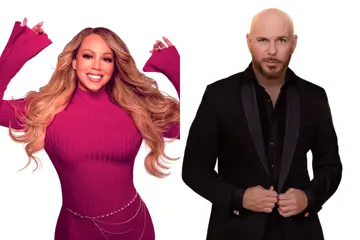 Dave Grohl
Dave GrohlBy their very nature, album covers have to be visually striking or make artistic statements. Invariably some fall foul of the law... or sheer opportunism.
The most famous of these is a good place to start, as it’s now gone back to the courts.
Nirvana – Nevermind (1991)

Last month, Spencer Elden (aka the ‘Nirvana Baby’) had a win in a three-year lawsuit against the grunge heroes.
Elden claimed in his lawsuit in August 2021 that the photo of him on the Nevermind cover – as a naked baby in a pool, reaching for a dollar bill on a hook – caused him emotional distress, lost earning capacity and “loss of enjoyment of life”. He claimed he was sexually exploited, suffered interest from pedophiles, was put in dangerous situations, and had to pay for a therapist.
Two years ago, a District Court judge rejected his claims because he had not filed within the ten-year “statute of limitations”. But Elden, who turns 33 in February, appealed with the argument that “the statute of limitations” didn’t apply because his injuries still continued to this day with reissues of Nevermind. Significantly, that same year, he married Angela Marie Najand Elden, a film industry worker who is also in the RCAN organisation that teaches about safety on production, such as reporting child abuse.
A three-judge panel on the US Court of Appeals for the 9th Circuit agreed wth Elden’s argument in December 2023, finding that “each republication” of an image “may constitute a new personal injury”.
Elden is asking for damages of $150,000 USD ($477,386 AUD) from each of the defendants, who include surviving band members Dave Grohl and Krist Novoselic; Kurt Cobain's estate; Cobain's widow Courtney Love; record labels Geffen and Universal Music; and photographer Kirk Weddle.
The cover design came from a TV doco on underwater births. Kurt Cobain mentioned it to Geffen's art director Robert Fisher. Stock photos were too graphic, and the photo agency wanted $7,500 a year for its use. So Fisher contacted Weddle, known for underwater shots, and offered a fee of $1,000.
It must be remembered that all decisions about the cover were strictly small-scale. Nirvana’s first album Bleach, released two years prior on the small Seattle label Sub Pop, had only sold 40,000 copies. No-one imagined that Nevermind would go on to sell 30 million, turn Nirvana into one of the biggest acts of the ‘90s and have the cover hailed as one of the most remarkable and iconic in rock history.
Weddle had a friend who worked in the film industry as a set builder. He and his wife had a four-month-old baby. They were paid $200. The shoot was done at Rose Bowl Aquatics Centre in Pasadena, California. It took an hour to set up, with a rescue diver on-hand, and tests shot using a doll. Elden’s father eased him into the pool (look closely and you can see his handprints on the baby). The shoot took five minutes, and 25 frames were shot before the baby started to cry.
Weddle had a good shot. But he told The Guardian he was nervous it was “such a dick shot. His unit was so prominent in the picture ... he’s a well-hung kid for a four-month-old, you know? I didn’t know if the label would go for it. So I went to a kids’ swim school and got half a dozen other babies in the water. This one girl was ten-months-old, she could really motor, so I shot her from the side. But the label loved the original shot of Spencer and went with that.”
Geffen also worried about the dick shot, though, and prepared a dickless version. But Cobain would only agree to a sticker covering the penis, reading, “If you're offended by this, you must be a closet paedophile.”
Elden’s parents say they were told the shoot was for a family project, and the penis wouldn’t be displayed. When they protested as the album became high profile, they allege they were threatened that his work would dry up. Elden would tattoo Nevermind on his chest, recreate the image (clothed) for articles, appear on a talk show in a nude-coloured onesie, and autograph copies of the album’s cover for sale on eBay.
Weddle said, “He’s conflicted about the picture. He feels that everybody made money off it and he didn’t. I think he deserves something. But it’s always the record labels that make the money.”
The Velvet Underground & Nico – S/T (1967)

The late pop artist Andy Warhol created the banana design for the cover of New York art-rock outfit The Velvet Underground’s first album.
In 2012, when Warhol’s Foundation For The Visual Arts wanted to license the image to Apple for iPhone and iPad accessories, the band – which was led by Lou Reed and John Cale, and broke up in 1972 – took action to stop its use, arguing it was “a symbol, truly an icon, of The Velvet Underground” for decades.
It would have been an interesting court case, as the banana design was not copyrighted. But in 2023, both sides settled out of court.
Cardi B – Gangsta Bitch Music Vol. 1 (2016)

“I want to kiss God’s feet,” an emotional Cardi B posted when a jury found in October 2022 that she won a $5 million lawsuit by one Kevin Brophy Jr.
The mixtape cover showed her lounging in the backseat of a limo, drinking from a bottle while a man with a distinctive tiger and serpent tattoo on his back gave her oral sex.
Brophy claimed Cardi B’s people found his body tag on the tattooist’s website, and superimposed it on the back of a real model used for the shot. He said its use was “misleading, offensive, humiliating and provocatively sexual”, and that he was a religious, happily married man with two young children.
The rapper’s peeps argued the model had been digitally altered elsewhere in the photo, resulting in a “newly created piece of art” protected by the First Amendment (freedom of expression). The jury found it did not violate Brophy’s publicity or privacy rights.
Van Halen – For Unlawful Carnal Knowledge (1991)

The blackboard on the cover featured a number of scribbled phone numbers. One belonged to guitarist Eddie Van Halen’s friend, Steve Ripley, a musician and guitar maker based in Tulsa, Oklahoma. But a blurred zero and an eight meant Van Halen fans began calling the McNutt family at all hours.
"We are very religious people," they said. "Having your phone number printed on a rock album can cause even your friends to question how sincere your beliefs are."
Aside from a $2 million lawsuit, the McNutts set up an answering machine message with two numbers – one owned by Van Halen’s record label, to give them a dose of the same medicine, and one for a priest to learn about Jesus Christ.
Dido – Safe Trip Home (2008)

NASA astronaut Bruce McCandless II didn’t own the copyright for the famous shot of his 1984 spacewalk, “free flying” about 320 feet away from the Space Shuttle Challenger. The shot showed him as a distant speck in his astronaut suit, had been in the public domain for a quarter of a century, and published countless times – including as a poster in NASA’s own gift shops.
But McCandless argued he licensed his persona for advertising, and without his permission, its use on the cover for Dido’s 2008 album Safe Trip Home affected future income from advertisers. It was a ridiculous claim, but he took on Dido, Sony Music and photo agency Getty. He settled in 2011, six years before his death at 80.
Placebo – S/T (1996)

When David Fox, from the English town of Scunthorpe in Lincolnshire, was 12, he lost his brother. His cousin, a professional photographer, visited from London and cheered him up by taking photos. A month later, the cuz called to tell him he was going to be on the cover of an album. The pic featured Fox in a baggy red jumper pulling on his face.
In 2012, he initiated litigation against the band, saying Placebo “ruined my life”. The album was a hit, and Fox says he was ostracised and bullied at school, forcing him to drop out, and later losing his job as a chef.
Skyhooks – Hooked On Hooks (1982)

Two years after Skyhooks split up, Mushroom Records tested the waters for a possible reunion tour with the release of Hooked On Hooks. It was a compilation of seven of their hits, backed with Red Symons’ Smut, about wanking in a porn cinema.
The 12-inch vinyl release featured an unauthorised photo of 16-year old Jacqueline Brumley, taken in 1976 at a concert at Waverley High School in Melbourne. It was used for the record’s B-side. In her court documents, Brumley said the use of the photo “caused me extreme embarrassment as the imputation contained by the word ‘smut’ is that I am a person of extremely loose morals and character”. The case was settled out of court.
The Rolling Stones – Some Girls (1978)

In a play on the album title, The Rolling Stones’ 14th British release had an artwork based on an old print ad for wigs by the Valmor Products Corporation.
Valmor was set up in 1926 Chicago to tap into the African American beauty market, using stylised packaging, black models and top visual artists. Album designer Peter Corriston used the Stones’ faces with those of celebrities. Many like Lucille Ball, Farrah Fawcett, Judy Garland, Raquel Welch and Marilyn Monroe (or their estates) called their lawyers for using their likenesses without permission.
All the faces were removed. Mick Jagger apologised to Garland’s daughter, Liza Minelli, when their paths crossed at New York’s Studio 54 nightclub. Valmor received a cash settlement for using their ad styles.
Dead Kennedys – Frankenchrist (1985)

An inset poster of biomechanical artist H. R. Giger's Landscape #XX, or Penis Landscape, led to two years of criminal legalities for the US hardcore leaders for distributing harmful matter to minors.
There were no convictions for either singer Jello Biafra or the Alternative Tentacles label, but both almost ended up bankrupt, and the band broke up after a final album – which is what authorities wanted.
The trial publicity also shone a light on the front cover, a 1970s Newsweek shot of secret Masonic cult Shriners in a parade. In 1986, four in the photo sued the band (and magazine) after identifying themselves. A decade later, the prosecutor, ex-LA deputy city attorney Michael Guarino, called the suit a mistake. He said authorities should “focus on the tremendous amount of conflict of interest at the top, the accountants, the lawyers, the politicians, and get out of the area of freedom of expression”.
Vampire Weekend – Contra (2010)

When Vampire Weekend came across a 1983 Polaroid of a woman online, they were intrigued by her expression. She seemed vague and uncertain. The band paid photographer Tod Brody, on whose Flickr page they found the photo, and paid $5,000 for its use.
The woman in the photo, Ann Kirsten Kennis, said it had been taken while she was "a high-fashion model under contract with prestigious agencies in New York City”. Alerted when her daughter brought home the #1 album Contra, Kennis sued the band, their label (XL Recordings) and Brody for $2 million.
She claimed that her signature on a 2009 photo release form was forged, and the photo had in fact been taken by her mother. She confidentially settled with the band and XL Recordings a year later, but her action, and that by the band, against Brody – who insisted he took the shot – continued.
Matchbox Twenty – Yourself Or Someone Like You (1996)

The sad-looking man in a flying helmet, on the cover of a debut album that sold ten million copies in the US alone, had more reason to look sadder. No-one knew who he was, and the band themselves made up stories during interviews that he built the sets on one of their videos, and his name was Ray Parker Jr. (alluding to the Ghostbusters singer).
In 2005, Frank Torres emerged to say he was the man on the cover, and he never gave his permission for the photo to be used. He was walking down the street when he was asked to stop and pose for a pic. It was never intended to be on a record cover.
The band’s version of the story was they were doing a photoshoot of their own, and Torres was in the background. They liked the expression on his face, so they used him. The lawsuit was dismissed, and Torres died in 2016 at the age of 73.






